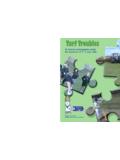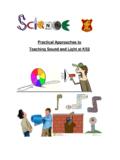Transcription of Energy Works KS2 Resource Pack - Resources for …
1 Energy Works KS2 Resource pack Produced by Nicky Ayscough & Richard Green, Cambridgeshire Environmental Education Service (CEES) from materials developed by Ruth Ruthven of Innovative Learning Projects for ScottishPower. 1 Energy Works KS2 Resource pack This KS2 Resource pack is designed to support teachers whose pupils are taking part in the Energy Works programme. This pack is designed to offer a variety of activities for your class for you to pick and choose which ones will benefit and suit your pupils. There are 18 sheets divided into four areas: Electricity (1 - 6) Wind Power (7 - 12) Weather (13 18) Most of the sheets are stand alone worksheets. However, Sheet 12 includes suggestions for teacher -led demonstrations. If you would like help or would like to comment on the pack , please contact Nicky Ayscough at Stibbington Centre on 01780 782386 or email Contents Page Energy Works 2 Curriculum Links 4 Coldham Wind Farm Facts 5 Index of Activity Sheets 6 Activity Sheets 7 - 25 Appendix 1 - Detailed Curriculum Links 26 Appendix 2 - Answers to Activity Sheets 27 2 Energy Works : AN INNOVATIVE ENVIRONMENTAL Energy PROJECT Energy Works is a unique new education programme which gives school children and adults across Fenland the opportunity to learn all about the environment and renewable Energy alongside other forms of Energy generation.
2 The programme is a joint arrangement between The Co-operative, ScottishPower Renewables, Fenland District Council and Cambridgeshire Environmental Education Service (CEES). The project is funded from annual environmental education payments made by the operators of several wind farm projects within Fenland District. Energy Works is run by the Cambridgeshire Environmental Education Service (CEES), and is based in the dedicated education centre in the farm buildings at Coldham. The Energy Works programme is tailored to each class and designed to cover a range of subjects including science, geography and design and technology for primary pupils from ages 6-11. The programme is also available to secondary school pupils and community groups. A typical primary programme will last two weeks and includes school workshops and a visit to the education centre, led by a CEES teacher , together with this Resource pack for use in school.
3 During visits to the education centre, schools and community groups have the opportunity to get close to the eight 2 MW wind turbines, which generate enough to power over 9000 homes. 3 The Visit to Coldham Wind Farm The visit will normally last either half a day or a full day depending on the number of classes (the facilities are suitable for one class at a time). On a half day visit the class will be fully briefed during the introduction and safety talk before travelling out to the turbines themselves where the will do a variety of fieldwork exercises as well as having the opportunity to see a turbine up close. On a full day visit there will also be the chance to take part in one of our workshops based in the education Centre. The Workshops These can be based at the education centre or back at your school. There are a number of workshops on renewable Energy using mini-kits to explore how renewable Resources are used to produce Energy . In addition there are design based workshops developing DT, Art and English skills in addition to Scientific and geographical understanding.
4 An 'at a glance' breakdown of curriculum links follows, or you can find a more detailed breakdown in appendix 1 For details of the workshops currently on offer please contact Nicky Ayscough at Stibbington Centre on 01780 782386 or email 4 Curriculum links Coldham Visit Fieldwork Science -Investigation skills, Materials, Electricity, Forces Geography - Geographical enquiry, Knowledge of place, Environmental Change and Sustainable Development Maths - Using & Applying number, Measurement, Handling Data English - Developing speaking skills Art - Field sketching Renewable Energy Workshops Science -Investigation skills, Materials, Electricity, Forces Geography - Environmental Change and Sustainable Development Maths - Using & Applying number, Measurement, Handling Data English - Developing speaking and writing skills Design Technology - Designing and Building, Evaluating Design Based Workshops Science -Investigation skills, Materials, Electricity, Forces Geography - Environmental Change and Sustainable Development English - Developing speaking skills Design Technology - Designing and Building, Evaluating Resource pack Activity Sheets Science -Investigation skills, Materials, Electricity, Forces Geography - Environmental Change and Sustainable Development English - Developing speaking and writing skills Design Technology - Designing and Building, Evaluating ICT - Developing ideas, finding information, using simulations For a detailed breakdown of the curriculum subject links from each activity see appendix 1 5 Coldham Wind farm facts Coldham Wind Farm is located at Coldham Hall Farm, a Co-operative Farm in between March and Wisbech in Cambridgeshire.
5 Coldham Wind Farm Ltd is a joint venture between The Co-operative Group and ScottishPower Renewables and the wind farm is managed by Natural Power. Wind turbine facts There are 8 Vestas V-80 wind turbines at Coldham. A further 7 turbines will be built in 2009 in the same area. There are 9 turbines in the adjacent Stags Holt wind farm and other wind farms can be seen on a clear day. The Coldham turbines are 60 m high to the hub and have three 40 m long blades. The amount of electrical power produced depends on the wind speed at the rotor (or blade) height. The turbines start to generate electricity at a wind speed of around 4 m s-1 and generate the maximum power of 2000 kW or 2 MW from a wind speed of around 14 m s-1. Computer linked wind-measuring equipment and a turning (yaw) mechanism ensures that the wind turbine faces into the wind to gain the maximum wind power. The turbine blades can swivel (pitch) in the rotor to increase or decrease their wind resistance.
6 At a steady strong wind speed of 25 m s-1, the turbine will turn off by pitching the blades to 86 to provide minimum resistance to the wind to prevent blade damage. A control system (called SCADA) operates and monitors the wind turbines. It can be accessed from anywhere in the world with Internet or mobile access with password protection. The 8 wind turbines at Coldham provide enough power to supply around over 9,000 homes each year. Each turbine costs around 2 million, or 1 million per MW maximum power. 6 Index of Activity Sheets Electricity Sheet 1 What do we use electricity for? Sheet 2 What is Energy ? Sheet 3 How long will fossil fuels last? Sheet 4 How much electricity do we use? Sheet -5 Electricity travels! Sheet 6 Supply and demand Wind power Sheet 7 The wind turbine - diagram Sheet 8 How a turbine Works ? Sheet 9 From a wind farm to our homes Sheet 10 Thinking about the wind Sheet 11 Where does the wind come from? Sheet 12 teacher Activity: It s a blow out!
7 Weather Sheet 13 Wind measurements Sheet 14 The Beaufort Scale Sheet 15 Recording the weather (7 days) Sheet 16 Make your own weather kit Sheet 17 Make your own weather kit 2 Sheet 18 Weather symbols 7 8 Sheet 1 What do we use electricity for? We use electricity for many items in our homes. Look at the objects below and tick whether you think they turn electrical Energy into heat, light, sound or movement. Warning: Sometimes you may need to tick more than one! Name: Date: Heat Light Sound Movement Heat Light Sound Movement Heat Light Sound Movement Heat Light Sound Movement Heat Light Sound Movement Heat Light Sound Movement Heat Light Sound
8 Movement Heat Light Sound Movement Heat Light Sound Movement 9 Sheet 2 What is Energy ? Use the words in the box to fill in the blank spaces. Use each word only once. Energy is the ability to do _ _ _ _ . It comes in many different _ _ _ _ _ . These are heat, light, mechanical, electrical, nuclear and kinetic (movement) Energy . We use Energy in everything we do, from jumping to watching television. There are two main sources for the Energy we use every day: Energy that is made using natural Resources that can be replaced, like wind, water and sunshine, is called _ _ _ _ _ _ _ _ _ Energy . This is also called clean Energy or green power because it does not pollute the air or water.
9 Non-renewable Energy sources are those that cannot be replaced once they are used, such as the _ _ _ _ _ _ fuels oil, natural gas and coal. Most of our electrical Energy comes from burning non-renewable Energy sources. Non-renewable Energy sources also cause pollution. Renewable and non-renewable Energy sources can both be used to produce _ _ _ _ _ _ _ _ _ _ _ . Another non-renewable Energy source is the metal called _ _ _ _ _ _ _ _ . Electricity made this way is called _ _ _ _ _ _ _ Energy . We use all these Energy sources to _ _ _ _ _ _ _ _ the electricity we need for our homes, work , schools and factories. renewable work forms electricity fossil uranium nuclear generate Name: Date: 10 Sheet 3: How long will fossil fuels last? Fossil fuels are coal, gas and oil. They were formed millions of years ago when dead plants and animals were pressed under layers of rock. They are non-renewable as once we have used them we cannot make any more. No-one knows exactly when they will run out, or how much we have left.
10 However, the bar chart below shows what some scientists think may happen in the next 200 years or so: Year Look at the bar chart What year is it now? Write the letter N on the time line. What year were you born? Write M (for me!) on the time line. What year will you be 50? Write X on the time line. What fossil fuels will you be able to use when you are 50? Will this change anything in your life? What could we do to save fossil fuels to make them last longer? 1980 2000 2020 2040 2060 2080 2090 2110 2130 2150 2170 2190 2210 2230 Name: Date: Oil Gas Coal Availability of fossil fuels 11 Sheet 4 How much Energy do we use? Electrical power lines come into your house or school through an electricity meter. The Energy company uses these meters to measure how much electricity has been used. The meter measures electricity in units called kilowatt hours (kWh). Note: 1 kWh is equal to 1000 watts of electricity used for one hour.





